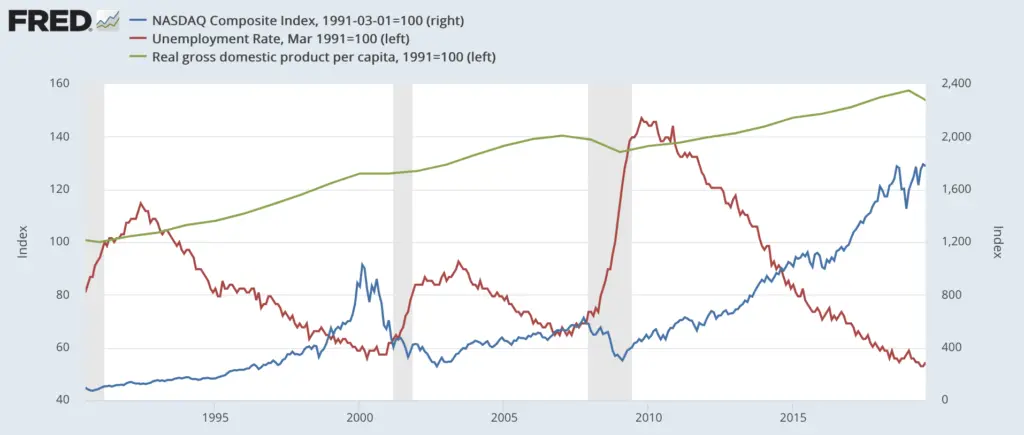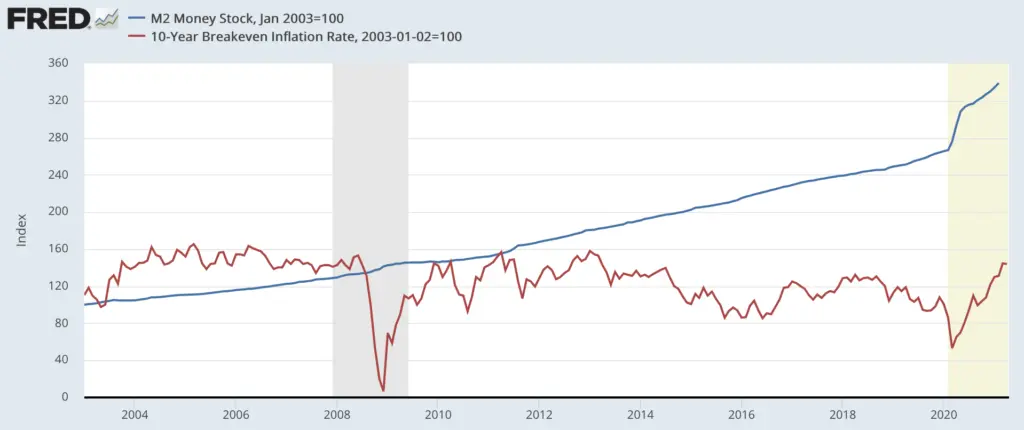Economics Explained and bad hyperinflation takes
TL;DR People with real money betting on inflation think the 10 year inflation rate will be around 2.4%. Also, Economics Explained makes bad content.
In their new video, Economics Explained talks about the apparently ongoing hyperinflation in the US.
Since Economics Explained is a mascot of r/badeconomics at this point, I imagine whatever they’ll have to say about hyperinflation is wrong, so I decided to comment this video as I watch it.
WARNING: I fully expect myself to just repeat “read Sargent (1984)” and “go look at 10-year TIPS spreads” for this entire article.
The Video
Spends the first few minutes talking about hyperinflation in Weimar Republic, Hungary and Zimbabwe. Then, around 2:25 drops this gem:
There are a few common trends: Some kind of destabilizing event which is corrected with stimulus measures funded by the printing of money. Unfortunately, almost all of these examples result in some form of failed state.
This gets the causality backwards.
Hyperinflation happens when people stop believing that new government debt will be repaid. A failed state precedes the hyperinflation event – people would buy the new government debt if they thought it had value. Mismanagement of monetary policy compounds the original problem.
Second, stimulus measures under an economic downturn is standard countercyclical policy (eg. emitting new debt during downturns and paying it off during booms). This is good because it dampens the business cycle – makes downturns shorter and tampers market manias. What matters is the numbers involved, simply doing this is normal.
Note that the central bank is more successful at countercyclical policy in a democracy because it’s an independent institution. Fiscal policy (eg. the government spending money) is dictated by politicians who answer to voters who get their information in idiotic youtube videos. So the government on average doesn’t quite hit the mark for “spend more in downturns” and “pay off that debt in good times”.
On the other hand, monetary policy (fiddling with the amount of money in the economy and the interest rate), which is dictated by the independent central bank, will tend to get countercyclical closer to correct, because it’s run by a bunch of nerds whose only goal is to keep unemployment low and inflation at 2%.
This is immediately followed by this:
Market crashes might sting a few investors and push average people’s retirements back a few years, but for those with the fortitude to hold onto a broad portfolio everything ends up fine.
What an astoundingly tone deaf comment.
The problem with a market crash isn’t that your robinhood account goes red. It’s that people might lose their jobs.
Compare the NASDAQ index, the unemployment rate and the GDP Per Capita:

Notice that, for an investor, the 2000 dot-com bubble was a worse event than the 2008 housing market crash. The 2008 financial crisis was worse for, you know, everyone else because it had a bigger effect on GDP and unemployment.
Around 3:15, they then state:
The only way to stop hyperinflation is a massive regime change, or total abandonment of a sovereign currency. Hyperinflation is Game Over.
I don’t expect Economics Explained to do serious research, but hyperinflation aficionados know counterexamples. This wasn’t the case in, say, the 1921 Austrian hyperinflation, which stopped after Austria agreed to make their central bank independent from the government to the League of Nations.
Hyperinflation is more of a political than economic problem. Again, “read Sargent (1984)”. The key procedure to stop hyperinflation is to make the central bank independent from the people running the government budget – from the conclusion: “The establishment of an independent central bank which is legally committed to refuse additional unsecured credit to the government”.
While regime change is often followed shortly, this is because the people running the failed state generally caused hyperinflation in the first place. For instance, nobody expects things to get better in Venezuela as long as Maduro is in power. However it’s at least possible stop the Bolivar from being worthless by isolating the central bank from Maduro.
United States of America, 2020
This section (around 4:00) starts with mentioning that the US central bank printed more than a third of the money supply in 2020, but it might “be different than historic cautionary tales”. Let’s break that down with a graph.

M2 Money Supply is a common measure of the amount of money in the economy.
The “10-Year Breakeven inflation rate” is the “TIPS Spread”, or the difference in price between inflation-protected government debt, or TIPS and regular government debt. The TIPS Spread is effectively what the market thinks what inflation will be at in 10 years. If someone thought that market predicted inflation is wrong they can make money by buying or shorting the regular (or inflation protected) debt.
We can see that the TIPS market reacts almost instantly to changes in macroeconomic variables that affect inflation. The increase in M2 money supply has been “priced in” a long time ago. People with real money on the line currently think inflation in 10 years will be around 2.4% (the current TIPS Spread).
Several minutes of poor inflation analogies later
We eventually come to to an argument that because parts of the stock market are up, there’s inflation (~9:10)
it’s fair to say that this collection of 500 companies [S&P 500] is less good than it was 16 months ago. It’s producing less, making less profits […] it would therefore stand to reason that all other things being equal this index would be exchangeable for fewer USD today […] in fact it’s actually exchangeable for 30 more dollars than it was at the beginning of 2020 so either this equation is totally illogical or the true value of dollars has fallen
(hint: it’s the former)
Stock prices reflect the expected future flow of profits, not the current value. Otherwise, companies not making profits would have a stock price of zero.
It’s possible that the monetary stimulus was misallocated into an asset bubble – lowering interest rates and pumping money into the economy serves to incentivize risk taking (more loans to businesses, etc.). In a pandemic it’s possible this investment fuels pure speculation rather than productive uses.
So far price hikes have been exclusively in asset markets like stocks, cryptocurrencies, real estate and raw materials. But despite the direct relationship between these markets and the markets for consumer goods and services the consumer price index that actually has remained stubbornly low.
You don’t get to choose subsets of the economy to make general claims about inflation. Apple having a growing market cap doesn’t mean there’s inflation. TV’s getting cheaper doesn’t mean there’s deflation, either.
Moreover, these are four entirely separate things with their own dynamics.
For instance, there’s a pretty clear speculative bubble in growth stocks (Tesla, Gamestop, etc.). Cryptocurrencies’ sole purpose is to be a speculative vehicle (and launder money) so they’re also in a bubble.
On the other hand, raw materials are at a premium largely because it’s hard to make them when there’s, you know, a pandemic throwing a wrench in supply lines.
House prices will be a topic for another day, but there are many trends between zoning regulations driving lack of inventory and almost all wage growth in the last 40 years being found in college educated workers living in cities – leading to this being captured by colleges and urban landowners respectively.
